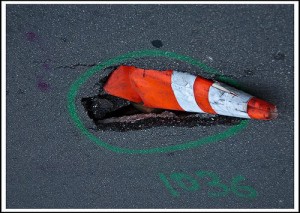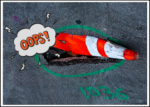Potholes: Chronic Key Signature & Accidental Disorders
My Dad taught me to drive. He spent many hours on the road in his job and was a demanding teacher. One day we were practicing on a back road that was full of potholes. I swear there were potholes on top of potholes and, hard as I tried to miss them, I hit every single one. Dad was uncharacteristically silent until finally he said, “Go back- you missed one.”
Do you ever feel like saying that about sharps and flats- except in reverse? “Go back- you played one.” Chronic Key Signature Disorder (CKSD) and Chronic Accidental Disorder (CAD) are rampant in the piano learning world.
Let’s face it, there are some people who get key signatures and accidentals and there are some people who struggle. Some people have great short term memories and some not so great. Some people have better senses of keyboard geography and spatial relationships than others. Some people just naturally have great ears.
Here are some ideas and thoughts to help with both CKSD and CAD.
Observing sharps, flats, and naturals is largely a function of experience. Those who play and learn only 4 pieces a year, or who play only in ‘easy’ keys, or who are self taught, are going to struggle. Playing lots and lots of short sight reading pieces weekly (more than 5) can go a long way toward correcting the problem. You don’t have to have a special book for this. Any collection of interesting pieces in varied keys and at an appropriate level will do. Choose a small section at a time- 4-16 measures depending on frustration tolerance. Work on 1 or 2 sections each day. Vary the pieces- don’t get stuck going through one 3 page piece 8 measures at a time for days on end.
When you are working out the notes, if you are going to name them then do so correctly. If the key signature is one sharp then say F# rather than F. If there is one flat in the key signature then say Bb not just plain B. You would think that this would be obvious, but it is not. Even college students need an occasional reminder. I actually came across an online video, on a site devoted to sight reading, in which the teacher made this mistake while pointing to the pitches.
Practice rhythms away from the keyboard. Sometimes rhythmic complexities can use up so much brain power that accidentals and key signatures get completely ignored, resulting in either CKSD or CAD. If you have trouble doing musical math, work to strengthen your rhythmic skills.
Learn to look ahead. The best pianists are always looking one or two measures ahead of what they are actually playing, depending on the density of the music. To learn to do this, try looking a beat ahead, then 2, then 3, until you can look at least a measure ahead at all times. Of course, this means that you have to have at least the first measure in mind when you begin to play!
Listen to the kind of music you want to play. Listening improves your ability to anticipate what will happen next when you play. I am not talking about listening to the piece you are learning but rather listening to a lot of pieces that are like that piece. Then, when you are practicing and learning, your ear will kick in and free up some brain power so you can attend to those pesky sharps, flats, and naturals.
The pianists who are most successful at key signatures and accidentals also possess good ears and a good sense of keyboard geography. They can use their senses of hearing, touch, and sight together with the map of the keyboard they carry around in their heads. Strengthening the ear by learning intervals, sight singing, and singing along while you play can help improve CKSD and CAD. Strengthening your sense of touch and spatial relationships through learning scales, arpeggios, chords/cadences, broken octaves, and the like can also improve these disorders.
Play air piano. Practicing and visualizing a piece away from the keyboard is a great way to strengthen your sense of touch and spatial relationships. You can also divide a passage into short (2-4 measure) sections and then alternate how you play each sections; section 1 in the air, section 2 on the keyboard, section 3 in the air, and so forth. Don’t forget to reverse the process. When playing air piano be sure that you are actually lining your fingers up over the correct imaginary white and black keys.
Learn to transpose and improvise on simple pieces- even if it is like pulling toenails! You don’t have to do it in front of others but it will improve the symptoms of both CKSD and CAD. Start transposing with easy pieces in 5 finger patterns with no more than 2 sharps or flats and no accidentals. Then move gradually to more complicated pieces and key signatures. You can use any piece or passage you like for improvisation. It can be as simple as changing one or two notes in a passage or changing just one harmony. The best thing about improvisation is that if you don’t like it, you don’t have to do it that way again.
Be sure you teach your brain all the trees first, then give it the whole forest. When you are learning a piece, divide it into manageable sections (2-4-6-8 measures) and then break it down into its component parts. Practice the rhythm, sing it away from the piano, play a little air piano saying the pitches aloud, decide which fingers to use, play a little more air piano saying finger numbers, count aloud and play hands apart, play and sing along, etc. Be creative and make a game of it rather than a chore.



